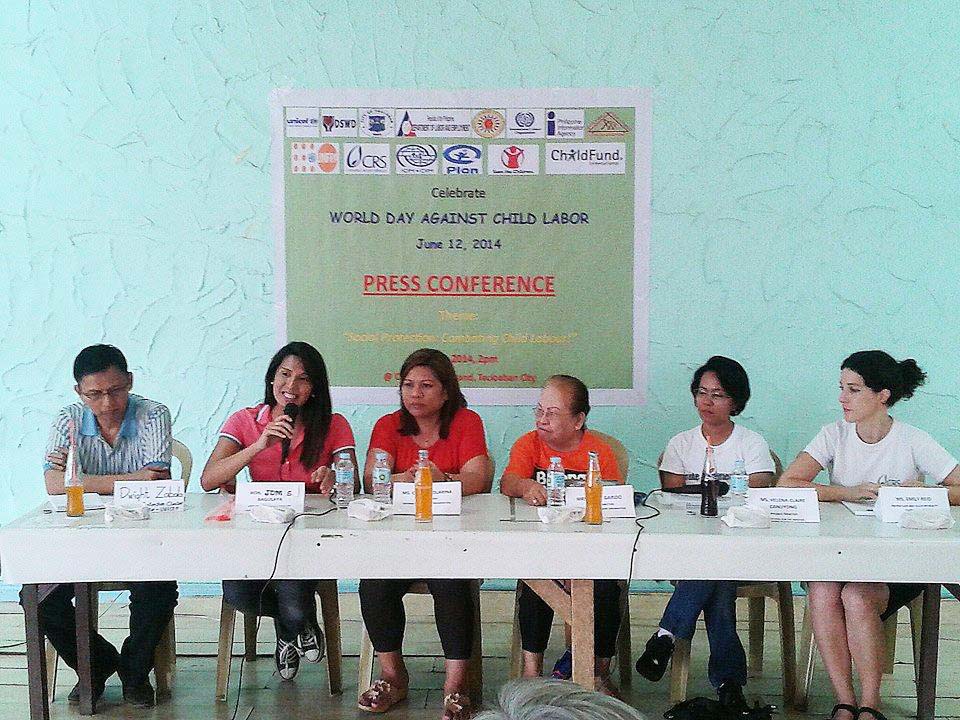TACLOBAN CITY-A training program called “Connecting Communities through the Creative Arts” was held at Leyte Normal University (LNU) by Spark Philippines with the Apl.de.ap Foundation on June 17-19, 2014. The training is an approach for trauma healing and community reconciliation through the use of different forms of arts in the affected areas of the supertyphoon Yolanda. The training was participated by educators, barangay health workers and people who are dealing with children (facilitators) for them to learn and gain knowledge on how to use arts for recovering from the trauma that Yolanda caused. The entire training program for the facilitators covered different procedures such as the creative arts, theatre of the living, hands-on activities, individual/group discussion, sharing, and presentation; teaching moments, personal/group reflections, storytelling, case studies, scenario-building, simulations, and documentary snippets. The Spark Philippines and the Apl.de.ap Foundation organized the gathering for children to learn and enjoy something, in the same way that facilitators will be able to use different procedures in dealing with children. “We are one nation; whatever happens in one place also happens in the whole country. So, we want to tell them that we are doing everything that we can to help them in the best way that we can,” Kate Alyzon Ramil, Sparks Philippines project coordinator, said. After the three3-day training program, a practicum well be held at the New Kawayan for children with the facilitators. The pilot training was in Tacloban and they will also visit the other places who are hit by disasters such as Cebu, Bacolod and Bohol. (KAYE ANNE ORALLER LNU-Intern)
Foreign grants to boost country’s fight against TB, set to reach Calbayog
CALBAYOG CITY – Foreign investments of up to P1 billion per year for the next three years pour in to the Philippines as we now reach number 4 among the 27 high-burden countries in terms of Multi-Drug Resistant Tuberculosis (MDR-TB) with an estimated 13,000 cases as of 2012. This after two international funding organizations, The Global Fund and United States Agency for International Development (USAID), granted funds on March this year through the PBSP (Philippine Business for Social Progress) worth USD$70M (from The Global Fund) and a separate USD$28 million (from USAID) for the implementation of projects to support the goals of the National Tuberculosis Program (NTP) in the Philippines. PBSP, a corporate-led, non-profit social development foundation in the Philippines, will extend support to anti-TB programs of local government units (LGUs), and one of those identified to receive such support is the city government of Calbayog. Kurt Baltero of the PBSP organization, during his visit to the city recently, said that they are set to put up PMDT (Programmatic Management of Drug Resistant Tuberculosis) Treatment Facility in the city which will be a DOTS (Directly Observed Therapy-Short Course) facility as well. Activities in the facility, he added, will start from case detection, treatment, surveillance, and monitoring of patients suffering from MDR-TB. MDR-TB is tuberculosis that is resistant to at least isoniazid (INH) and rifampicin (RMP), the two most powerful first-line treatment anti-TB drugs. Treatment for those diagnosed as MDR cases will take minimum of two years, according to Baltero. Aside from the facility, other PBSP’s support that Baltero mentioned are manpower augmentation, staff trainings, equipment to start up operations, diagnostic services, financial assistance to patients, and facility budget for operational expenses. Baltero likewise stressed that the “would-be” counterpart of the LGU for this project is only an infrastructure support in place that can cater 10-20 patients, and one HR support that will ensure security and upkeep of all project-provided equipment and supplies in the facility. Other partners of PBSP in their fight against MDR-TB are the WHO (World Health Organization), MSH (Management Sciences for Health) and IMPACT (Innovations and Multisectoral Partnerships to Achieve Control of Tuberculosis). (AIMEE CATALAN/PR)
Healthy walk marks this year’s nutrition month celebration
TACLOBAN CITY – The regional National Nutrition Council (NNC-8) has lined up month-long activities for the national nutrition month on July According to Dr. Catalino “Kattie” Dotollo Jr., NNC nutrition program coordinator, said that this year’s theme is very timely in the light of frequent and devastating disasters that struck the country and how the families can cope without sacrificing the good nutrition of each one in the communities especially the children. This year’s theme observance is “Kalamidad Paghandaan: Gutom at Malnutrisyon Agapan,” with the celebration now on its 40th year. The month-long activities will start with a healthy walk on July 1 at 6:00 a.m. to start at the Balyuan grounds along Magsaysay Boulevard, this city. The government and private agencies are enjoined to participate in the healthy walk. “We are expecting 300 participants from our partner agencies, the government and the private sectors, the barangay nutrition scholars (BNS), UNICEF and other international humanitarian organizations,” said Dotollo. NNC is the lead agency in the nationwide launching and observance of the National Nutrition Month every July. After the healthy walk, Dotollo said that a short program follows with Tacloban City Mayor Alfred Romualdez as guest of honor. The theme for this year’s celebration will be unveiled by Mayor Romualdez, Dr. Dotollo and Emma Grande of the United Nations International Children’s Fund, the partner humanitarian agency of NNC for the event. There is also an agri-fair which will be open to the public. Among the month-long activities are symposium: Nutrition in Emergency Preparedness; government agency-hopping for nutrition counseling; cooking contest with recipe for cooking contest; Barangay Nutrition Scholars in Action (audio-visual presentation how the BNS responded in the aftermath of Yolanda) and culminates with the Nutrition Summit to be hosted by the UNICEF. The National Nutrition Month is observes pursuant to Presidential Decree 49 or the National Nutrition Act of the Philippines, signed on June 25, 1974. (VICKY C. ARNAIZ)
“A Useless Nonsense”; “Where’s the Evidence?”
 Senator Koko Pimentel III sounds quite credible, when he described the digital file of whistle blower Ben Hur Luy relative to the PDAF scam as a “useless nonsense” Observers of this scam are beginning to be blurred by recent happening on account of so many lists of suspect legislators in both houses of Congress involved in this thievery to include personalities of agencies in government. With over a hundred suspects allegedly involved in this unprecedented corruption of the century in the Philippines, it will take years before this is going to be terminated with the guilty suspects behind bars. Then again and out of the blue, we read the banner story that appeared in the June 1 issue of the Philippine Daily Inquirer saying that the affidavits executed by the queen and mother of all scams, Janet Lim-Napoles, charging legislators as recipients of P10B pork barrel scam, would just be mere scrap of paper without strong evidences to support her allegations. If the National Bureau of Investigation officials who expressed these doubts will only depend on paper-signed evidences by suspects then no solution is at hand to put these “honorable” officials behind bars for the crime committed. No one among these suspects would sign any “receipt” for what they “stole” from this scam. The NBI however can employ and extensively explore other viable strategies to strengthen their cases against these traitor-politician in our midst.
Senator Koko Pimentel III sounds quite credible, when he described the digital file of whistle blower Ben Hur Luy relative to the PDAF scam as a “useless nonsense” Observers of this scam are beginning to be blurred by recent happening on account of so many lists of suspect legislators in both houses of Congress involved in this thievery to include personalities of agencies in government. With over a hundred suspects allegedly involved in this unprecedented corruption of the century in the Philippines, it will take years before this is going to be terminated with the guilty suspects behind bars. Then again and out of the blue, we read the banner story that appeared in the June 1 issue of the Philippine Daily Inquirer saying that the affidavits executed by the queen and mother of all scams, Janet Lim-Napoles, charging legislators as recipients of P10B pork barrel scam, would just be mere scrap of paper without strong evidences to support her allegations. If the National Bureau of Investigation officials who expressed these doubts will only depend on paper-signed evidences by suspects then no solution is at hand to put these “honorable” officials behind bars for the crime committed. No one among these suspects would sign any “receipt” for what they “stole” from this scam. The NBI however can employ and extensively explore other viable strategies to strengthen their cases against these traitor-politician in our midst.
Role of parents against child labor underscored


Parents take a crucial role in eliminating child labor in the country, especially among those in the grassroots level and those in indigenous communities whose natives are largely unlettered. This is a emphatically raised by representatives of government institutions and non-government agencies who recently had an interaction with local media to drumbeat the celebration of World Day Against Child Labor bannering the theme “Social Protection Combating Child Labor.” Cecile Colarina of the International Labor Organization reiterated the penal sanction that could be imposed on parents who push their children to forced labor, domestic work, prostitution or other similar lascivious trade under RA 9281. Albeit punitive, the law provides measures that are restorative on the part of the erring parents and other forms of intervention with recourse to mobility of the quick action team that will give focus on this societal menace. The major yoke however is on the funding that the government should give to give teeth to the letter of this law and provide the required half-way home for children in the locality. For now, the ILO-Philippines could not provide a data as to the number of parents who have been subjected to the punitive provisions of the anti-child labor law. “We give parents the time to understand the situation,” Helena Claire Canayong, director of Volunteer for the Visayas, clarified, adding that this will make the problem easier. The ILO reported that there were about 317 million economically active children aged 5 to 17 in 2004, of whom 218 million could be regarded as child labourers, 126 million of which were engaged in hazardous work. It noted a decline in the statistics of child work in that the more harmful the work and the more vulnerable the children involved, the faster the decline .The incidence of child labour (percentage of children working) in 2004 is estimated at 13.9 per cent for the 5-17 age group, compared to 16 per cent in 2000. “The number of child labourers in both age groups of 5-14 and 5-17 fell by 11 per cent over the four years from 2000 to 2004. The decline was much greater for those engaged in hazardous work: by 26 per cent for the 5-17 age group, and 33 per cent for 5 to 14 year-olds. The proportion of girls among child labourers, however, remained steady’” the ILO noted. Oone of the most effective methods of ensuring that children do not start working too young is to set the age at which children can legally be employed or otherwise work,” the ILO advanced, The ILO’s Convention has set the following standards concerning the minimum age of admission to employment and work are as follows. For hazardous work or any work which is likely to jeopardize children’s physical, mental or moral heath, safety or morals, it should not be done by anyone under the age of 18. Basic minimum age for work should not be below the age for finishing compulsory schooling, which is generally 15. Children between the ages of 13 and 15 years old may do light work, as long as it does not threaten their health and safety, or hinder their education or vocational orientation and training. This now fits the meaning of child labour in globally accepted terms that is “work that is prohibited for children of certain age groups. It is work performed by children who are under the minimum age legally specified for that kind of work, or work which, because of its detrimental nature or conditions, is considered unacceptable for children and is prohibited.” Like Colarina, Tacloban City Councilor Jom Bagulaya calls on the full support of all stakeholders on this pursuit, with much emphasis on the role of parents in inculcating the rights values in children, and being true parents to their children not forcing them into work that is detrimental to the well being of the children. Their children should instead be brought back to school and not expose them harmful environment such as child labor.
Back to school
 ANOTHER school year opens and I am now again back to school. It’s just one among many other pastoral assignments given to me this year. But I welcome this opportunity to be involved in a school, since the exciting task of forming people is made easier by the more or less controlled and structured conditions schools have. Still I know I have to keep myself strong inside and outside to tackle all the burden that undeniably is also great, and even daunting. Just the same, I also know that it also has its sweet and gratifying moments. It’s not all sweat and blood, my friend. As chaplain, I say Mass everyday for everyone there—students, teachers, staff, some parents and guests. I hear confessions, conduct recollections, retreats and doctrine classes, and sit for hours in the confessional for personal spiritual direction. These are very delicate tasks but also a very privileged honor. Not everyone gets the chance to be of help and to make some crucial impact on the most intimate aspects of the lives of young people. Much of this work is done hidden and in silence, without fanfare and worldly rewards. But what consoles is the thought that that’s how things and persons grow. And if I do things well, I know that together with God’s grace, I would be making a big difference in the lives of people. It’s in these personal chats that I can clarify matters and issues, give pieces of advice and words of encouragement, sow reasons for hope and broaden minds and hearts by pointing to our ultimate common goal while learning how to avoid getting entangled along the way. My desire is to be able to motivate and inspire people. In a sense, I would be walking and journeying with them. And given current world conditions, the effort is not without difficulties. Complicated minds and attitudes have taken root in many people. One really has to be very patient and creative with them, knowing how to make timely detours, when to stop, when to go, etc. The effect of all this task is many times very heartwarming, as people make welcome changes in their lives. Some people think miracles do not happen anymore these days. My experience is different. I see miracles taking place every day, though most of them do not have external manifestations. Among the things I do in school is to give a class on Christian morality to high school seniors. While I have been giving classes and talks on this topic, there’s always the challenge of how to present the same ideas and doctrine especially to young people whose mental and emotional framework may be a bit, if not, a lot different from what I’m used to. There’s always the need to adapt oneself to his audience. He needs to be most perceptive of the subtle shifts of mentality that takes place among people through the years and to attune himself to those conditions. It cannot be denied that giving classes also involves some skills in performance and theatrics to be able to catch and keep the attention of the students. Especially when the students are young, the teacher has to contend with the notorious fickle-mindedness of these students. But he should not lose sight of the essential things to be imparted. Due preparation is a must in giving classes. A teacher has to bear in mind that his presence alone should project a certain wholesomeness that would attract the young students, including the laziest and the most distracted and inattentive ones. He should try his best that he is consistent himself with what he is teaching. What frustrates students most is when they see their teachers not living what they are teaching. In this class on Christian morality, I immediately felt the need to clarify what morality is not. That’s because nowadays, many people, especially the young, come with very distorted ideas and biases against the mere mention of morality. I had to say that morality is not just about human sexuality, though a good part is dedicated to it since it is where many of us have our weakness, if not, our Waterloo. Neither is morality simply about rules, though rules there also are. The challenge is how to make a keen sense of morality an integral, natural part of one’s thinking, speaking and acting. Sad to say, with the thick cloud of confusion nowadays, many people have practically lost this sense, and if they still have it, it is quite damaged, needing repair.
ANOTHER school year opens and I am now again back to school. It’s just one among many other pastoral assignments given to me this year. But I welcome this opportunity to be involved in a school, since the exciting task of forming people is made easier by the more or less controlled and structured conditions schools have. Still I know I have to keep myself strong inside and outside to tackle all the burden that undeniably is also great, and even daunting. Just the same, I also know that it also has its sweet and gratifying moments. It’s not all sweat and blood, my friend. As chaplain, I say Mass everyday for everyone there—students, teachers, staff, some parents and guests. I hear confessions, conduct recollections, retreats and doctrine classes, and sit for hours in the confessional for personal spiritual direction. These are very delicate tasks but also a very privileged honor. Not everyone gets the chance to be of help and to make some crucial impact on the most intimate aspects of the lives of young people. Much of this work is done hidden and in silence, without fanfare and worldly rewards. But what consoles is the thought that that’s how things and persons grow. And if I do things well, I know that together with God’s grace, I would be making a big difference in the lives of people. It’s in these personal chats that I can clarify matters and issues, give pieces of advice and words of encouragement, sow reasons for hope and broaden minds and hearts by pointing to our ultimate common goal while learning how to avoid getting entangled along the way. My desire is to be able to motivate and inspire people. In a sense, I would be walking and journeying with them. And given current world conditions, the effort is not without difficulties. Complicated minds and attitudes have taken root in many people. One really has to be very patient and creative with them, knowing how to make timely detours, when to stop, when to go, etc. The effect of all this task is many times very heartwarming, as people make welcome changes in their lives. Some people think miracles do not happen anymore these days. My experience is different. I see miracles taking place every day, though most of them do not have external manifestations. Among the things I do in school is to give a class on Christian morality to high school seniors. While I have been giving classes and talks on this topic, there’s always the challenge of how to present the same ideas and doctrine especially to young people whose mental and emotional framework may be a bit, if not, a lot different from what I’m used to. There’s always the need to adapt oneself to his audience. He needs to be most perceptive of the subtle shifts of mentality that takes place among people through the years and to attune himself to those conditions. It cannot be denied that giving classes also involves some skills in performance and theatrics to be able to catch and keep the attention of the students. Especially when the students are young, the teacher has to contend with the notorious fickle-mindedness of these students. But he should not lose sight of the essential things to be imparted. Due preparation is a must in giving classes. A teacher has to bear in mind that his presence alone should project a certain wholesomeness that would attract the young students, including the laziest and the most distracted and inattentive ones. He should try his best that he is consistent himself with what he is teaching. What frustrates students most is when they see their teachers not living what they are teaching. In this class on Christian morality, I immediately felt the need to clarify what morality is not. That’s because nowadays, many people, especially the young, come with very distorted ideas and biases against the mere mention of morality. I had to say that morality is not just about human sexuality, though a good part is dedicated to it since it is where many of us have our weakness, if not, our Waterloo. Neither is morality simply about rules, though rules there also are. The challenge is how to make a keen sense of morality an integral, natural part of one’s thinking, speaking and acting. Sad to say, with the thick cloud of confusion nowadays, many people have practically lost this sense, and if they still have it, it is quite damaged, needing repair.


